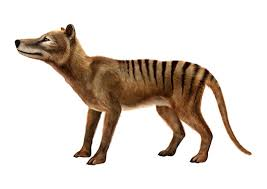Important Facts For Prelims
Recovering RNA From Extinct Tasmanian Tiger
- 23 Sep 2023
- 3 min read
Why in News?
In recent years, researchers have successfully retrieved DNA (DeoxyriboNucleic Acid), from ancient animals and plants, with specimens dating back over 2 million years. However, A recent study represents the first instance where RNA (Ribonucleic Acid), a molecule less stable than DNA, has been extracted from extinct species such as the Tasmanian Tiger.
Note:
The ability to extract, sequence and analyze old RNA could boost efforts by other scientists toward recreating extinct species. Recovering RNA from old viruses also could help decipher the cause of past pandemics.
What is the Difference Between DNA and RNA?
|
Characteristic |
DNA (Deoxyribonucleic Acid) |
RNA (Ribonucleic Acid) |
|
Sugar Component |
Deoxyribose |
Ribose |
|
Nitrogenous Bases |
Adenine (A), Cytosine (C), Guanine (G), Thymine (T) |
Adenine (A), Cytosine (C), Guanine (G), Uracil (U) |
|
Number of Strands |
Double-stranded (usually) |
Single-stranded (usually) |
|
Structure |
Forms a double helix |
Generally single-stranded |
|
Bases Pairing |
A pairs with T, C pairs with G |
A pairs with U, C pairs with G |
|
Function |
Stores genetic information |
Carries genetic information, protein synthesis |
|
Location |
Found in the nucleus of cells, mitochondria, and chloroplasts |
Found in the nucleus, cytoplasm, and ribosomes |
|
Stability |
Stable and less prone to degradation |
Generally less stable, more susceptible to degradation |
|
Role in Protein Synthesis |
Serves as a template for mRNA synthesis |
Serves as a template for protein synthesis |
|
Types |
Mainly exists as genomic DNA and mitochondrial DNA |
Several types, including messenger RNA (mRNA), transfer RNA (tRNA), and ribosomal RNA (rRNA) |
What are the Key Facts About Tasmanian Tiger?
- The Tasmanian tiger, or thylacine (a dog headed pouched dog) was an exclusively carnivorous marsupial that is considered to be extinct (also the IUCN status).
- It is also known as the Tasmanian Wolf and bears some resemblance to a dog, with its distinguishing features being the dark stripes beginning at the rear of its body and extending into its stiff tail and abdominal pouch.
- It was confined to Tasmania in recent times and disappeared from mainland Australia over 2000 years ago, mainly because of over-hunting by humans, diseases and competition from the Dingo (Canis lupus), a wild dog native to Australia.
UPSC CSE PREVIOUS YEAR QUESTIONS (PYQs)
Q. Consider the following statements : (2017)
- DNA Barcoding can be a tool to:
- assess the age of a plant or animal.
- distinguish among species that look alike.
- identify undesirable animal or plant materials in processed foods.
Which of the statements given above is/are correct?
(a) 1 only
(b) 3 only
(c) 1 and 2
(d) 2 and 3
Ans: D





